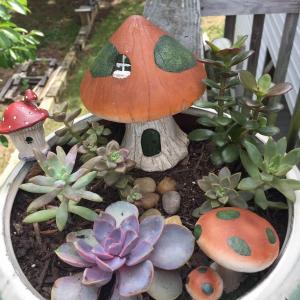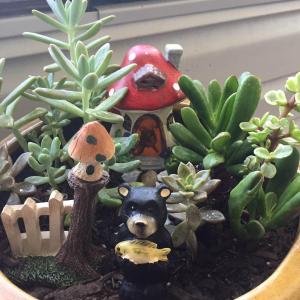文章
Miss Chen
2017年08月07日


Crocosmia

No late summer flower garden is complete without crocosmia's vibrant wands of scarlet, red, orange, and yellow. They offer a late pop of color when many gardens are languishing in the dog days. Their narrow, bladed foliage provides vertical accents much like gladiola leaves. The tubular blossoms beckon hummingbirds, and the seedpods that persist into fall also attract feathered visitors. Plant crocosmia bulbs in well-drained soil in fall or spring.

LIGHT:Sun
TYPE:Bulb
HEIGHT:From 1 to 8 feet
WIDTH:To 3 feet wide
FLOWER COLOR:Green, Orange, Red
FOLIAGE COLOR:Chartreuse/Gold
SEASONAL FEATURES:Summer Bloom
PROBLEM SOLVERS:Deer Resistant, Drought Tolerant, Good For Privacy, Groundcover, Slope/Erosion Control
SPECIAL FEATURES:Attracts Birds, Cut Flowers, Good for Containers, Low Maintenance
ZONES:6-10

0
0
文章
Miss Chen
2017年08月07日


Crinum

Spidery, sweet scented crinum flowers dangle from a central stem, brightening late-summer gardens. The huge leafy plants spring from giant bulbs. The native Southern swamp lily depends on summer rain to set its perfumed flowers in motion. In colder climates, crinums are a botanical curiosity to show off on a summer patio, and then bring indoors to overwinter.

LIGHT:Part Sun, Shade, Sun
TYPE:Bulb
HEIGHT:From 6 inches to 8 feet
WIDTH:To 5 feet wide
FLOWER COLOR:White
SEASONAL FEATURES:Colorful Fall Foliage, Fall Bloom, Spring Bloom, Summer Bloom, Winter Bloom, Winter Interest
PROBLEM SOLVERS:Deer Resistant, Drought Tolerant
SPECIAL FEATURES:Attracts Birds, Cut Flowers, Fragrance, Good for Containers, Low Maintenance
ZONES:7-10

0
0
文章
Miss Chen
2017年08月07日


Canna
Cannas bring tropical splendor to gardens in all regions. These bold plants feature clustered, flaglike blooms in a brilliant color array on tall stems. Recent flower breeding has created canna foliage that is even showier than the petals, with variegated leaf combinations of orange, yellow, and greens that glow in the summer sun. Dwarf cannas are also available for container gardening and other small spaces. Cannas are usually grown from tuberous roots but some newer varieties can also be raised from seed, with flowering guaranteed for the first year.

Cannas provide architectural interest in summer borders and they also flourish along the damp margins of a pond. If you garden in a climate colder than Zone 9 (7 for the hardier types of cannas), you'll need to dig canna plants up and store them bareroot for the next season or overwinter potted specimens indoors. A destructive mottling virus has threatened canna stock in nurseries across the U.S., so be sure to buy your plants from a reputable source.

LIGHT:Part Sun, Shade, Sun
TYPE:Bulb
HEIGHT:From 1 to 8 feet
WIDTH:To 3 feet wide
FLOWER COLOR:Orange, Pink, Red, White, Yellow
FOLIAGE COLOR:Purple/Burgundy
SEASONAL FEATURES:Summer Bloom
PROBLEM SOLVERS:Deer Resistant, Good For Privacy, Groundcover, Slope/Erosion Control
SPECIAL FEATURES:Attracts Birds, Fragrance, Good for Containers, Low Maintenance
ZONES:9-11

0
1
文章
Dummer. ゛☀
2017年08月07日

Distribution
The Criown Anemone is native to the Mediterranean region of Europe, but because of its beauty this lovely wildflower has been taken in to cultivation and can be seen in parks and gardens in many other parts of the world.
In 2013 Anemone coronaria was chosen as Israel's national flower.
Habitat and Blooming Times
Anemones generally shun dry places, and so woodland edges and damp grassland are places where these kinds of flowers are most likely to be seen. Anemone coronaria blooms from January to April and can be found on roadsides, meadows and the grassy slopes in the hills.
The Crown Anemone Anemone coronaria is the most common of the many anemone species that occur in the Mediterranean region of Europe, where they are frequently grown in gardens as well as being found in the wild.
The Criown Anemone is native to the Mediterranean region of Europe, but because of its beauty this lovely wildflower has been taken in to cultivation and can be seen in parks and gardens in many other parts of the world.

In 2013 Anemone coronaria was chosen as Israel's national flower.
Habitat and Blooming Times
Anemones generally shun dry places, and so woodland edges and damp grassland are places where these kinds of flowers are most likely to be seen. Anemone coronaria blooms from January to April and can be found on roadsides, meadows and the grassy slopes in the hills.

The Crown Anemone Anemone coronaria is the most common of the many anemone species that occur in the Mediterranean region of Europe, where they are frequently grown in gardens as well as being found in the wild.
0
0
文章
Dummer. ゛☀
2017年08月07日

More than 200 microspecies of Alchemilla vulgaris are known to exist in Europe. These perennial wildflowers, members of the rose family, are sometimes grown in gardens - mainly for their leaves, which collect sparkling water droplets.
Identification
The distinctively corrugated and lobed (5 to 11 lobes with the upper leaves having fewer) kidney-shaped to semicircular leaves of Alchemilla make identification to genus level fairly straightforward.
The yellowish-green flowers form clusters. Each individual flower is typically 3mm in diameter, with no true petals but a four-lobed epicalyx, four sepals and usually four but sometimes five stamens.
Distribution
Alchemilla vulgaris is widespread and common throughout Britain and Ireland; it is also found throughout mainland Europe. This plant is also recorded as occurring in Greenland.
Habitat
Lady's Mantle is commonly seen in unimproved or lightly fertilised grassland, on roadside verges and banks, in chalk downland and on mountain slopes.
Blooming Times
In Britain and Ireland the tiny flowers of Alchemilla vulgaris can be seen from June through to September.
Similar Species
Alchemilla mollis, a rather larger species but otherwise very similar, is quite a common garden escape that sometimes appears in hedgerows and on unkempt grassland.
Uses
Lady's Mantle, which contains salicylic acid, has sedative properties and has been used to alleviate cramps and menstruation pains.Another traditional use of this plant is as an astringent; it contains tannin and has styptic properties. In the past the leaves were used to dress wounds, rather as Stachys species (woundworts) were.

Identification
The distinctively corrugated and lobed (5 to 11 lobes with the upper leaves having fewer) kidney-shaped to semicircular leaves of Alchemilla make identification to genus level fairly straightforward.
The yellowish-green flowers form clusters. Each individual flower is typically 3mm in diameter, with no true petals but a four-lobed epicalyx, four sepals and usually four but sometimes five stamens.

Distribution
Alchemilla vulgaris is widespread and common throughout Britain and Ireland; it is also found throughout mainland Europe. This plant is also recorded as occurring in Greenland.
Habitat
Lady's Mantle is commonly seen in unimproved or lightly fertilised grassland, on roadside verges and banks, in chalk downland and on mountain slopes.
Blooming Times
In Britain and Ireland the tiny flowers of Alchemilla vulgaris can be seen from June through to September.

Similar Species
Alchemilla mollis, a rather larger species but otherwise very similar, is quite a common garden escape that sometimes appears in hedgerows and on unkempt grassland.
Uses
Lady's Mantle, which contains salicylic acid, has sedative properties and has been used to alleviate cramps and menstruation pains.Another traditional use of this plant is as an astringent; it contains tannin and has styptic properties. In the past the leaves were used to dress wounds, rather as Stachys species (woundworts) were.
0
0
文章
Dummer. ゛☀
2017年08月07日

For people living in Britain and Ireland, Candytuft in the form of a cultivar is associated with neat, edged flowerbeds in gardens and parks in the height of summer.
Identification
The flowers of Burnt Candytuft, a dwarf rock plant, are 3 to 6 mm across and have four notched petals; they are variable in colour and can be white, pink or mauve. Stems range from 3 to 35 cm tall and have a rather woody base.
Distribution
Burnt Candytuft is found in the western and central Mediterranean from Spain eastwards to Greece and also in Sardinia, Sicily and Crete.
Habitat
This member of the brassicaceae (Cabbage family, formerly known as cruciferae) grows in rocky habitats in the hills and mountains.
Blooming Times
Burnt Candytuft blooms in springtime.
Identification
The flowers of Burnt Candytuft, a dwarf rock plant, are 3 to 6 mm across and have four notched petals; they are variable in colour and can be white, pink or mauve. Stems range from 3 to 35 cm tall and have a rather woody base.

Distribution
Burnt Candytuft is found in the western and central Mediterranean from Spain eastwards to Greece and also in Sardinia, Sicily and Crete.
Habitat
This member of the brassicaceae (Cabbage family, formerly known as cruciferae) grows in rocky habitats in the hills and mountains.

Blooming Times
Burnt Candytuft blooms in springtime.
0
0
文章
扭扭
2017年05月23日

Learn how to grow cucumbers vertically to get the most productive plant. Growing cucumbers vertically also save lot of space, which is suitable for small gardens.
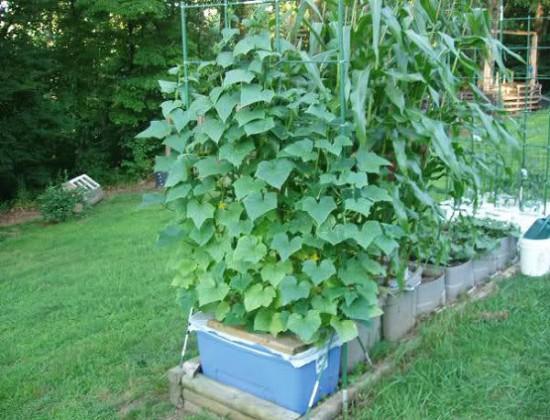
Cucumber is a refreshing vegetable, especially if picked up fresh. It is eaten in variety of ways: raw in salad, cooked or pickled. It is easy to grow and only requires a warm, sunny exposure and deep and regular watering.
What if you want to grow cucumbers but you have a small garden. Definitely, it will take a lot of space. In that case growing cucumbers vertically is an space savvy option.
Benefits of Growing Cucumbers Vertically
One advantage of Growing Cucumbers Vertically is that by this you can avoid a common problem of fruit rot associated with cucumber cultivation, which happens when fruit sitting in moist soil for long period of time. When you allow cucumber vines to grow up vertically, it improves the air circulation around the plant that prevents fungal diseases. Cucumber plants have sprawling habit and growing cucumbers vertically allow their leaves to absorb more sun, which result in healthy plant and large cucumbers. One more key benefit is that you can harvest the fruits more easily and in time.
Why you should grow cucumbers vertically
When cucumbers grown horizontally they usually cover 10 – 20 sq ft of space, plant sprawls over the surface around it. However, smaller and bushier varieties take only 1/3 of this space but they produce less fruits. Climbing, vine type varieties are more productive and when you grow them vertically they barely take 1 sq ft of space, climbing up on the support of trellis.
How to Grow Cucumbers VerticallyChoosing Container and Trellis
If you’re growing cucumbers vertically in containers, prefer large containers that are about at least 12 inches deep and wide. How many cucumber plants you can grow in such a container depends on the variety you are planting. A vining variety grows tall and send long roots, whereas bushier varieties are short.
Trellis Size
Choose a 5 to 6 feet tall trellis that is sturdy and doesn’t topple. If growing climbing varieties use “A frame trellis” so that the plant crawl up and down from it easily.
Propagation and Planting Cucumbers
Sow seeds directly onto the desired spot or in small pots. Cover them with about 2 cm of soil. Once the seedlings germinate and have a few leaves, transplant the healthiest ones into a bigger pot or on the frost free ground in spring or summer when soil temperature is around 70 F (20 C). If you live in tropical or subtropical climate, you can grow cucumber year round.
Cucumber plant is a heavy feeder like tomatoes, prepare your soil well before planting by incorporating decomposed manure and compost.
Requirements for Growing Cucumbers VerticallyPosition
Cucumber loves a warm and sunny exposure that is less windy. It does not tolerate temperature below 50 F (10 C). Optimum temperature to grow cucumbers fall in the range of 60 – 95 F (15 – 35 C).
Soil
It prefers well drained, loose and deep soil, rich in organic matter and neutral in pH.
Watering
Regular and deep watering is the key of productive harvest, when growing cucumber. It is due to the high water content of its fruits. While watering, avoid wetting the foliage as it may encourage fungal diseases.
Mulching
Mulch around the base of plant to improve moisture retaining ability of soil.
Fertilizer
At the time of planting add all purpose slow release fertilizer in soil. Once the plant starts to flower, side dress the plant with aged manure. Also apply balanced liquid fertilizer at that time according to manufacturer’s instructions.
Diseases and Pests
Cucumber plants particularly suffer from anthracnose, powdery mildew and in pests look out for aphids.
HarvestWhen and how to harvest cucumbers?
Cucumbers are ready for harvest in 60 to 90 days after seed sowing, depending on the variety. Pick cucumbers when they are developed enough, do not
let the fruit to overripe.

Cucumber is a refreshing vegetable, especially if picked up fresh. It is eaten in variety of ways: raw in salad, cooked or pickled. It is easy to grow and only requires a warm, sunny exposure and deep and regular watering.
What if you want to grow cucumbers but you have a small garden. Definitely, it will take a lot of space. In that case growing cucumbers vertically is an space savvy option.
Benefits of Growing Cucumbers Vertically
One advantage of Growing Cucumbers Vertically is that by this you can avoid a common problem of fruit rot associated with cucumber cultivation, which happens when fruit sitting in moist soil for long period of time. When you allow cucumber vines to grow up vertically, it improves the air circulation around the plant that prevents fungal diseases. Cucumber plants have sprawling habit and growing cucumbers vertically allow their leaves to absorb more sun, which result in healthy plant and large cucumbers. One more key benefit is that you can harvest the fruits more easily and in time.
Why you should grow cucumbers vertically
When cucumbers grown horizontally they usually cover 10 – 20 sq ft of space, plant sprawls over the surface around it. However, smaller and bushier varieties take only 1/3 of this space but they produce less fruits. Climbing, vine type varieties are more productive and when you grow them vertically they barely take 1 sq ft of space, climbing up on the support of trellis.
How to Grow Cucumbers VerticallyChoosing Container and Trellis

If you’re growing cucumbers vertically in containers, prefer large containers that are about at least 12 inches deep and wide. How many cucumber plants you can grow in such a container depends on the variety you are planting. A vining variety grows tall and send long roots, whereas bushier varieties are short.
Trellis Size
Choose a 5 to 6 feet tall trellis that is sturdy and doesn’t topple. If growing climbing varieties use “A frame trellis” so that the plant crawl up and down from it easily.
Propagation and Planting Cucumbers
Sow seeds directly onto the desired spot or in small pots. Cover them with about 2 cm of soil. Once the seedlings germinate and have a few leaves, transplant the healthiest ones into a bigger pot or on the frost free ground in spring or summer when soil temperature is around 70 F (20 C). If you live in tropical or subtropical climate, you can grow cucumber year round.
Cucumber plant is a heavy feeder like tomatoes, prepare your soil well before planting by incorporating decomposed manure and compost.
Requirements for Growing Cucumbers VerticallyPosition
Cucumber loves a warm and sunny exposure that is less windy. It does not tolerate temperature below 50 F (10 C). Optimum temperature to grow cucumbers fall in the range of 60 – 95 F (15 – 35 C).
Soil
It prefers well drained, loose and deep soil, rich in organic matter and neutral in pH.
Watering
Regular and deep watering is the key of productive harvest, when growing cucumber. It is due to the high water content of its fruits. While watering, avoid wetting the foliage as it may encourage fungal diseases.
Mulching
Mulch around the base of plant to improve moisture retaining ability of soil.
Fertilizer
At the time of planting add all purpose slow release fertilizer in soil. Once the plant starts to flower, side dress the plant with aged manure. Also apply balanced liquid fertilizer at that time according to manufacturer’s instructions.
Diseases and Pests
Cucumber plants particularly suffer from anthracnose, powdery mildew and in pests look out for aphids.
HarvestWhen and how to harvest cucumbers?
Cucumbers are ready for harvest in 60 to 90 days after seed sowing, depending on the variety. Pick cucumbers when they are developed enough, do not
let the fruit to overripe.
1
0
文章
扭扭
2017年05月23日

The correct selection of plants plays an important role in the design and functioning of vertical living wall gardens. In this article, we show a selection of the best plants for vertical gardening.
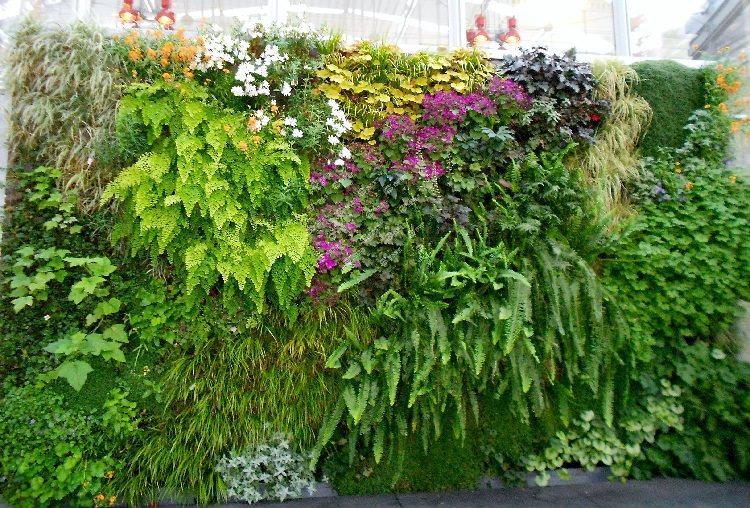
Best Plants For Vertical Garden
Not all plants adapt well to vertical gardening. They must have certain important characteristics for proper development and growth.
Ferns
They are one of the garden plants that are preferred for their adaptability and humidity resistance. Ferns are easy to grow and they cover the area quickly. You can grow sword fern, blue star fern, bird’s nest fern, they are easiest. Ferns will generally grow downward, so you’ll need to grow other covering plants with them too.
Bromeliads
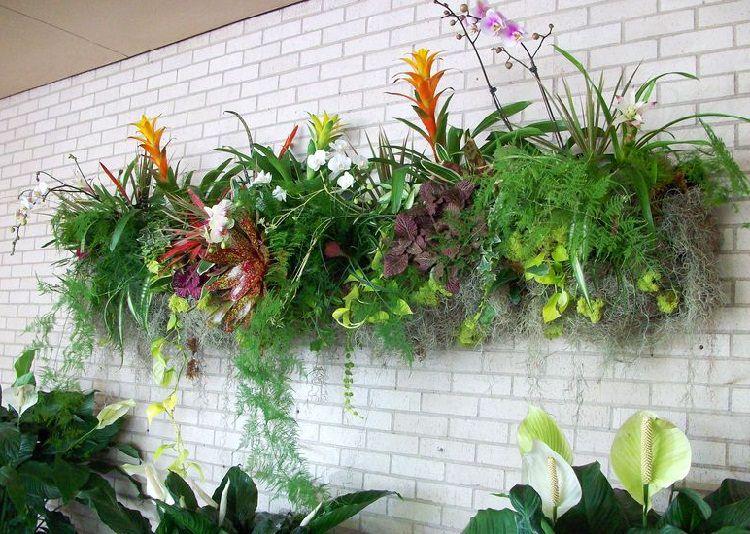
Most bromeliads have shallow roots and they need little space to grow this makes them ideal plants for vertical gardens. Their colorful leaves and long lasting flowers can be a good addition to your vertical garden.
Begonias
If you are hanging your living wall in a place that receives some sun then growing begonias is a good idea.
Hostas
This beautiful plant with variegated foliage is used as a groundcover in gardens. For a shady site, this evergreen plant is suitable for a vertical garden.
Lipstick Plant
Growing lipstick plant is easy. It doesn’t require deep soil to grow so it can thrive in a vertical wall. You can also grow it indoors.
Must Read: How to Make a Vertical Wall Planter
Succulents
Succulents are the most used plants for vertical gardens due to their incredible adaptability and resistance to fluctuation in temperatures and climatic variations. Plants like the string of pearls, echeveria, crassula and sedum can be considered.
Air Plants (Epiphyte)
Such plants do not need soil to thrive, they grow naturally on other plants, which makes them perfect for growing in vertical wall gardens. Tillandsias, aechmea, vriesea are a few examples.
Vines
Low maintenance vines such as pothos, ivies, philodendrons, rosary vine and wandering jew can be grown vertical planters easily. They are low maintenance and even thrive in indirect sunlight.

Best Plants For Vertical Garden
Not all plants adapt well to vertical gardening. They must have certain important characteristics for proper development and growth.
Ferns
They are one of the garden plants that are preferred for their adaptability and humidity resistance. Ferns are easy to grow and they cover the area quickly. You can grow sword fern, blue star fern, bird’s nest fern, they are easiest. Ferns will generally grow downward, so you’ll need to grow other covering plants with them too.
Bromeliads

Most bromeliads have shallow roots and they need little space to grow this makes them ideal plants for vertical gardens. Their colorful leaves and long lasting flowers can be a good addition to your vertical garden.
Begonias
If you are hanging your living wall in a place that receives some sun then growing begonias is a good idea.
Hostas
This beautiful plant with variegated foliage is used as a groundcover in gardens. For a shady site, this evergreen plant is suitable for a vertical garden.
Lipstick Plant
Growing lipstick plant is easy. It doesn’t require deep soil to grow so it can thrive in a vertical wall. You can also grow it indoors.
Must Read: How to Make a Vertical Wall Planter
Succulents
Succulents are the most used plants for vertical gardens due to their incredible adaptability and resistance to fluctuation in temperatures and climatic variations. Plants like the string of pearls, echeveria, crassula and sedum can be considered.
Air Plants (Epiphyte)
Such plants do not need soil to thrive, they grow naturally on other plants, which makes them perfect for growing in vertical wall gardens. Tillandsias, aechmea, vriesea are a few examples.
Vines
Low maintenance vines such as pothos, ivies, philodendrons, rosary vine and wandering jew can be grown vertical planters easily. They are low maintenance and even thrive in indirect sunlight.
1
0
文章
Hande Salcan
2017年05月23日


Your garden doesn’t have to be a flamboyant display of bright blooms to be a “garden”. In fact, some of the most interesting gardens in the world rely on foliage to supply color and interest. Green is not the only color of leaves, either. The plant world is full of varied choices full of color, texture and form that can carry off a fun, whimsical space, or the most formal and elegant of gardens. How, and why would we garden with just foliage, not flowers? Glad you asked…

Why?
Foliage gardens require less upkeep, since they don’t require the deadheading that flowering plants do.
Green is one of the most visually calming colors, so planting a garden with foliage tends to make a space worth relaxing in.
Without flowers, a visitor to the garden tends to look closer, appreciating the texture of a leaf, and the variations of color and form. In short, a foliage garden can be a plant lovers dream.
An ‘all foliage’ garden tends to look pretty for a longer season…flowering plants use so much energy – they tend to go quiet a good part of the year when they aren’t in flower.

How to Use Foliage, not Flowers
First of all, the same old rules of design apply to foliage plants.
Plant in groups of 3 or more, and contrast textures, form and colors. This is easier to do in a foliage garden because you don’t have the changing colors of flowers at different times of the year to think about when planting the original design. What yous see, is generally what you will get all season long, with minor exceptions.
Plant sun plants in sun, shade plants in shade.
Plant water loving plants together so they can get extra attention from the hose, and drought tolerant plants farther out where they might not get watered as frequently.
Learn what colored foliage looks best with what. There are all kinds of guidelines out there, but I say this is the place to experiment and learn about basic design by trying different combinations. Some places to start? Yellow/green varieties tend to contrast nicely with gray or purple leaved plants. Variegated or pattered leaves look best next to a solid green for contrast, without looking too busy. Brightly colored foliage, such as reds look best as a focal plantings, with simple leaves nearby to set them off.
Don’t forget about form and texture, which can be very important when you are using just leaves for your garden interest. Large, bold leaved hostas look amazing next to the fern like leaves of a bleeding-heart. A tall vertical ornamental grass may be a great “exclamation point” to break up a bed of low growing sedums. You get the idea. Contrast.

Now that you have the gist of it, try foliage plants for gardens. Or try a small foliage garden in one corner with just three. It’s a great way for any plant lover to really get to know what gardening is all about, and a great design lesson too. I want to thoroughly recommend a book called Fine Foliage by Karen Chapman and Christina Salwitz. This book was a best gardening book Amazon 2013, and with good reason. Great photos, and great advice for foliage combinations. (And no, I don’t get anything for saying that! They also have a great gardening blog as well, with amazing ideas.
So give foliage gardening a go, it’s rewarding and lower maintenance as well.
1
1
文章
Micky
2017年05月23日


As summer reaches it’s peak, now is the time to start thinking about fixing up the garden at the end of the season. The fact is, most gardens look a bit tired by the time September rolls around. If you plan ahead, you can be prepared with one of these top annual flowers for fall, and brighten up your garden space. There is still a lot of growing season left after the kids go back to school, so don’t neglect what can be the nicest time of year to be outdoors! Keep in mind, if you want your fall annuals to bloom and fill in for fall, late summer is the time to get them in the ground. So let’s take a look at fall annuals, and fix that garden!
Our first couple of easy fall annuals are seeded, so you definitely need to think ahead. However, because they are from seed, it couldn’t be easier! Just make sure they are getting regular water, as you will be planting them in the heat of the summer so they will be ready for fall bloom. Plan to scatter these seeds 4-6 weeks before you want flowers… my bet would be late July into the middle of August.
Alyssum – Alyssum is one of the easiest flowers to grow, by seed or otherwise. Once you plant it, you will always have it in the garden, because it self seeds prolifically. A low growing plant, it flowers white, pink or purple from spring through fall. If you planted this in the spring, it has likely gotten rangy and stopped blooming. You can try cutting it back by half and giving it a dose of liquid fertilizer. However, the seed is so cheap and easy, I would just plant fresh ones for fall. Simply sprinkle the seed along walkways and borders and water in… You should see plants in a few days, and flowers in less than 4 weeks, with them growing larger and flowering more as the season moves on. Will flower until hard frost.

Sunflowers – Sunflowers are another simple seed plant, and they will bloom well into fall. Plant the seed just under the soil and water, 6 weeks before the start of fall, then plant more every 2 weeks until late August. Remember, the flower head will face the sun, so don’t plant them where the flower head will always face away from where you view them.

Nasturtiums – Nasturtiums are a good choice for areas that have cool falls… I like to soak the seeds in water overnight, then plant 1/4 inch below the soil. Plant out 6 weeks before fall bloom. Will bloom until frost. Try not to water late at night, because they can be prone to powdery mildew when the weather cools. They can grow as a short vine or trailer, or they have more compact varieties for bedding. Be sure to read the seed packet.

Morning Glory and Moonflower – Both these are vines, and their names say it all. Morning glories love cooler weather and bloom in the early part of the day, so nick the seed and soak them overnight in water, then plant 1/2 under the soil 6 weeks before bloom is wanted. Moonflowers bloom at the end of the day with gorgeous white flowers. These are great to carry over a rose arbor or other summer blooming vine. They are annuals, so they won’t hurt the existing vine, and they will die back after frost. Keep in mind, both these plants are poisonous if eaten.

The next fall annuals do not grow well from seed, so they need to be nursery bought. That does mean you are at the mercy of the nursery. But most nurseries order their plants early, so your plants can get established in the garden before bloom. Do remember to mulch and water well if you are still having a lot of summer heat. I plant my fall annual starts 4 weeks before I want bloom.
Pansies and Violas – These are old fashioned favs, and many self seed to ensure you have these happy blooms next spring and fall as well! In many different colors, they don’t spread too far in the fall, so plant them close. Give them liquid fertilizer every two weeks, and water them well, especially when hot out. Many will bloom through frost and up until the holidays! Containers or garden beds. Love!


Mums – Mums are the standby, and although they are technically perennials, in many areas they are grown as annuals, and priced as such. Plant from quart or gallon pots for an immediate show, but even the 4 inch pots will bloom well. Plant them 4 weeks before bloom, and cut back the flowers that are on the plant when you bought them. I know this is painful, but it will ensure new and healthy blooms when fall arrives in all it’s glory! Liquid fertilizer every two weeks will give you a great show. I like to choose one color for the whole garden to give it a fresh look. Using just one color unites the garden with a larger plant like this, some can grow to over two feet wide and high. Love sun!

Snapdragons – Snapdragons are another cool weather plant, so if you plant them in late summer to encourage fall bloom, treat them just like mums, with one exception. If you can protect them from afternoon sun in a warm climate, you will have more success.
Ornamental Greens – Add color to the fall garden with something more than flowers… Ornamental greens love the cooler weather of fall, plant from seed 6 weeks before, or from starts 4 weeks before fall bloom. Chard, lettuce and greens, and Kale are all great choices. You can even harvest them for fall meals!

Ornamental Grasses – Grasses tend to go on clearance this time of year, and many of them are perennials but at these prices, can be treated as annuals. You won’t get a lot of growth from them this late in the year, but they can add texture to a garden that has some gaps from summer annuals pooping out.

Easy, right? Planning ahead can ensure you fall garden is, amazing, not tired.
0
0
文章
Micky
2017年05月23日


As a gardener, I love to get holiday gifts that reflect my love of, well… gardens! In fact, I don’t know anyone who doesn’t love to get a living gift during the holiday season. Rather than be one of those people who just pick up a boring houseplant at the grocery store on the way to the party, (you know who you are!) this year put some thought into creating some DIY holiday plant gifts. We have some great ideas for how to take some simple plant material and turn it into a thoughtful, one of a kind gift, that keeps on giving. Our feature project above, is a simple burlap paperwhite pot from ‘Maya Made’… So easy, but the burlap pot wrap puts in that extra touch!
Another paperwhite project from ‘Domaphile’, these paperwhites in mason jars would make such cute hostess gifts!


From the community at ‘Home Depot’ learn to make these amazing mini rosemary topiaries. A fast project, and who wouldn’t want to be elbows deep in rosemary for an afternoon? The gifts are just a bonus!

More DIY rosemary topiaries from ‘City Farmhouse’…

From ‘Lolly Jane’, we love these chalk paint DIY succulent pots… You could do these in white, and wrap with a blue or silver Christmas ribbon.

If you want a unique gift, learn how to make these succulent Christmas trees, just like this one from ‘Canvas and Canopies‘… Here is a step by step video from ‘Urban Dirt’ on making succulent trees…

Here is an easy idea… pot up small transplants of aromatic herbs in recycled cans, then wrap with wide burlap ribbon in holiday style… From ‘Celebrate Magazine‘.

From ‘Gardenista‘, another easy way to take a simple plant gift, and dress up the delivery… And you probably already have all the supplies!

Lastly, another wrap idea, from ‘Segreto‘…

So give “green”!
>>> Want more info on how to force bulbs for holiday gifts? Check out our post on “How to Force Bulbs”
0
0
文章
Gina
2017年05月23日

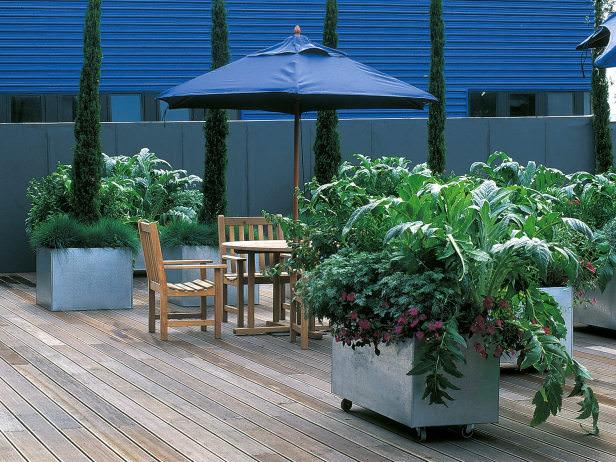
A lot of us love our container gardens… They allow you to grow things in a small space, or in a “no garden” space like a balcony, they cut down on maintenance chores, and they bring plants right up to the places you spend time so you can enjoy them! Oh, and they are pretty, too! But did you know you can go beyond the traditional annuals in a container? Almost anything can be grown in a container when the right requirements are met, don’t be afraid to think out of the box. (Or pot!) First, a quick refresh on the basics for container gardening.
Always match the size of the container to the size of the plants, especially large plants. Nothing makes a container garden fail faster than outgrowing it’s space too quickly!
That having been said, plants in container should be placed closer together than they would be in the ground. Everything is concentrated into a smaller space, including water and fertilizer, so they can tolerate, and look better, planted snugly. This especially applies to annuals that have shallow root systems and only last one season.
Always choose a good potting mix for your container, never use garden soil. Garden soil placed into containers is not light enough and will compact, not allowing the roots to breathe.
Containers need lots of water. In the heat of summer, especially smaller containers may need watering every day. You can set up a drip system if you group your containers together. Also, watch for pots that dry out extremely fast… Dark colored pots, metal pots or porous pots like terra cotta can be zapped of water in a few hours in the hot summer sun.
Fertilizer also leaches out of the container faster. Use a diluted liquid fertilizer every two weeks for most container grown plants. Consider using a potting mix with fertilizer pre-mixed in, like Miracle Gro.
One of the benefits of using containers is that they are mobile. Remember to outfit larger containers with wheeled platforms to make moving them easier, or use a hand truck.
Here are our picks for best unexpected plants you can grow in containers.
Our first picks are from ‘HGTV Gardens‘, both above and below. The top photo is a great example of using containers with unexpected plants. The focal plant (the taller spiky one) in these mobile containers are artichokes! Filled in with perennials and annuals, these containers offer a great aesthetic, and veggies too. Below is an example of using containers to create a typical hedge. Instead of plantings these boxwood straight in the ground, they are higher up to block views, and can be moved if necessary. Yep, they look cool too.
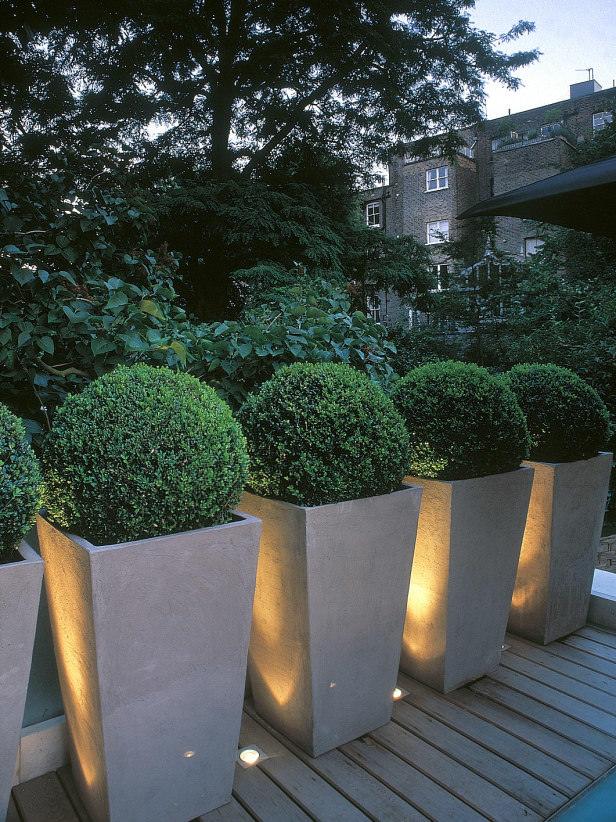
Don’t think you can plant trees in containers? Think again. These birch trees are placed in large containers, and because the root ball is kept from growing outward, the whole tree remains smaller and more manageable. Oh, yes, did we mention you can move them? Photo by ‘My Landscapes‘.
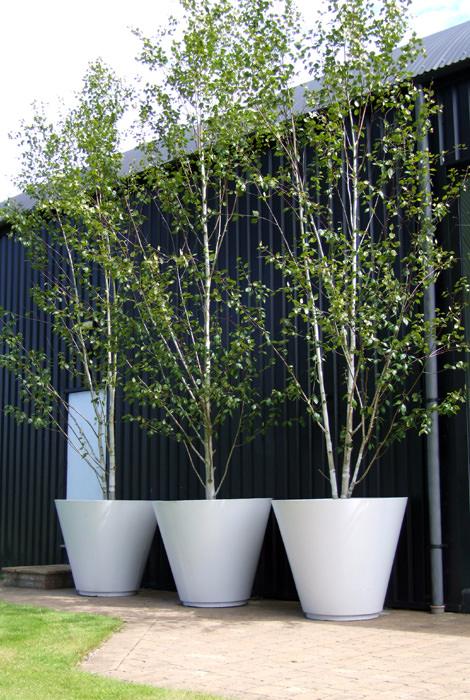
Want trees that give a little bit more? ‘A Cultivated Nest’ shows us how to grow apple trees in containers. She uses them as screens, and the apples are a bonus! There are lots of other type of fruit trees that come in dwarf or columnar varieties as well. Check out her tip on self pollinating varieties.
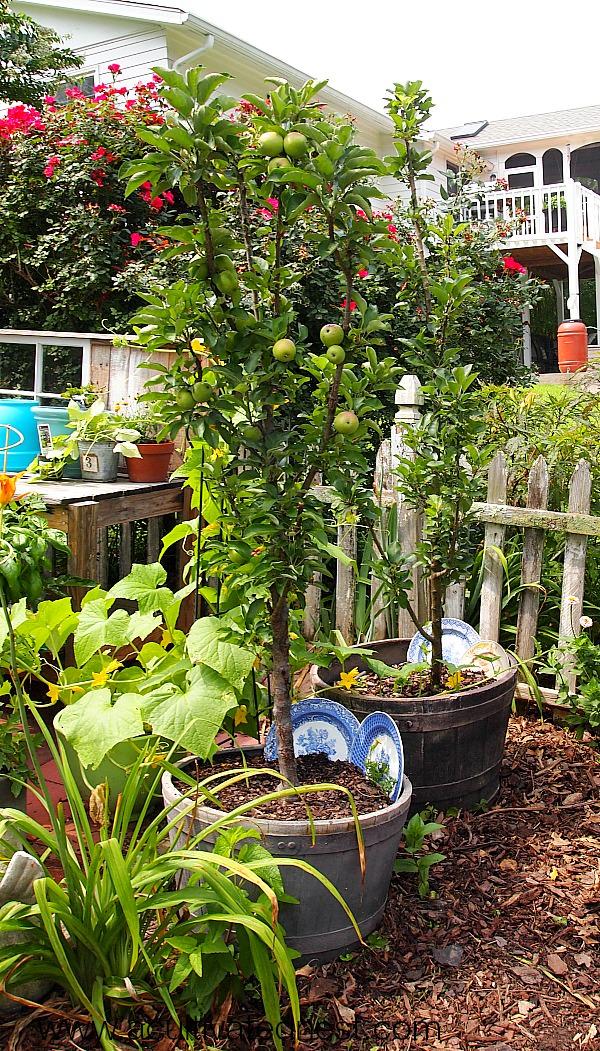
Citrus trees can be tough to grow in some parts of the country. Did you know that if you grow them in containers, you can bring them into a sunroom or sunny window for the winter? Photo by ‘HGTV‘.
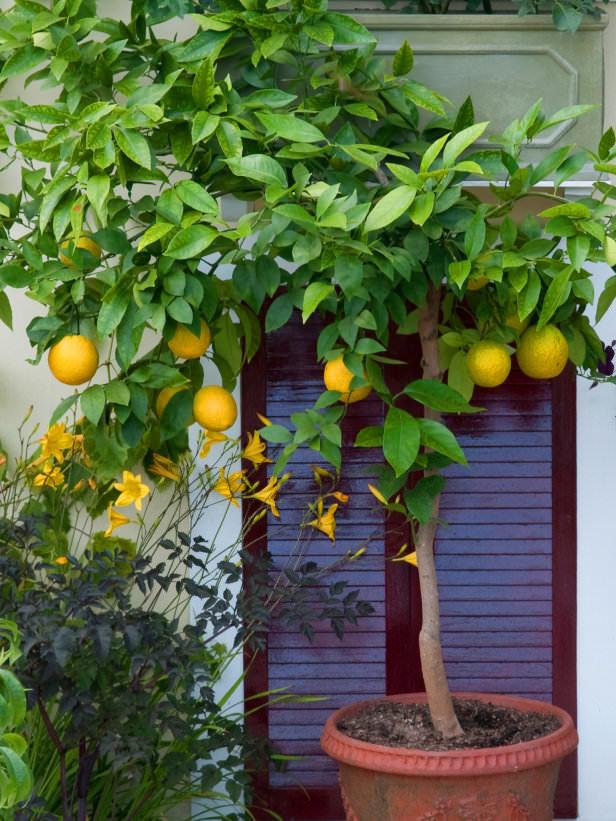
You already know there are many veggies you can grow in pots… Watermelon? You think I’m kidding, don’t ya’? Well jump on over to ‘Gardening Know How‘ and find out how to grow these veggies that are traditionally a space hog, in pots!

You may have seen small decorative bulbs in pots at the nursery, but what about larger bulbs and tubers, like Iris and Dahlias? They can be grown successfully in pots as well. Photo by ‘HGTV‘.
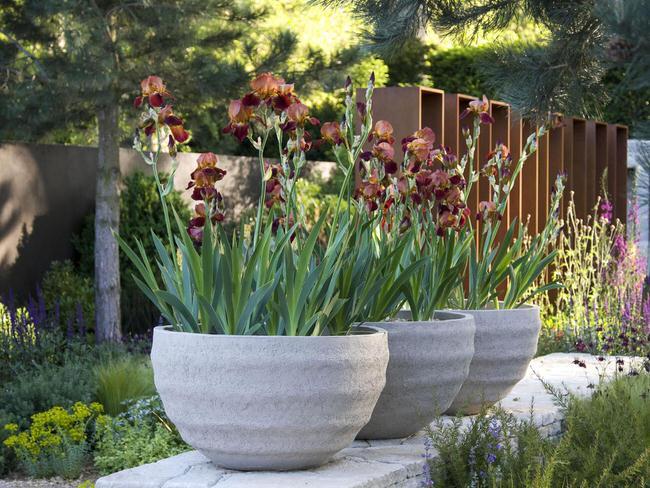
Vines can also grow in pots, you just need to make sure they have proper support. You can either set the pot in front of a wall or trellis, or provide a teepee within the container so that it can be moved when necessary. Photo by Taylors Clematis.
From ‘BHG’, learn how to grow berries in containers. These raspberries and blueberry plants do great when the right varieties are chosen, and they receive enough sun.
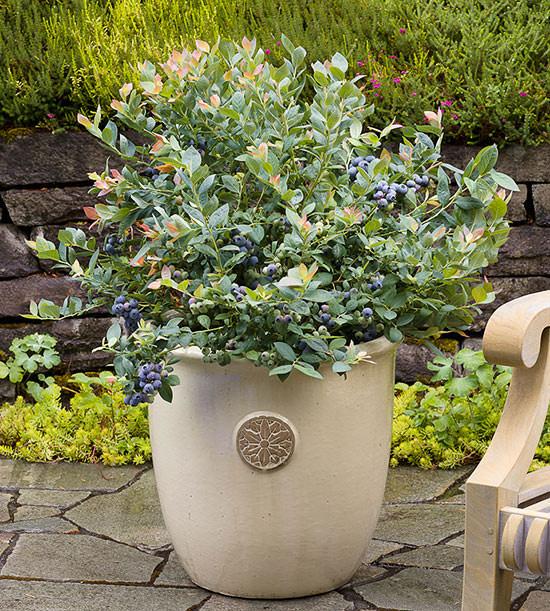
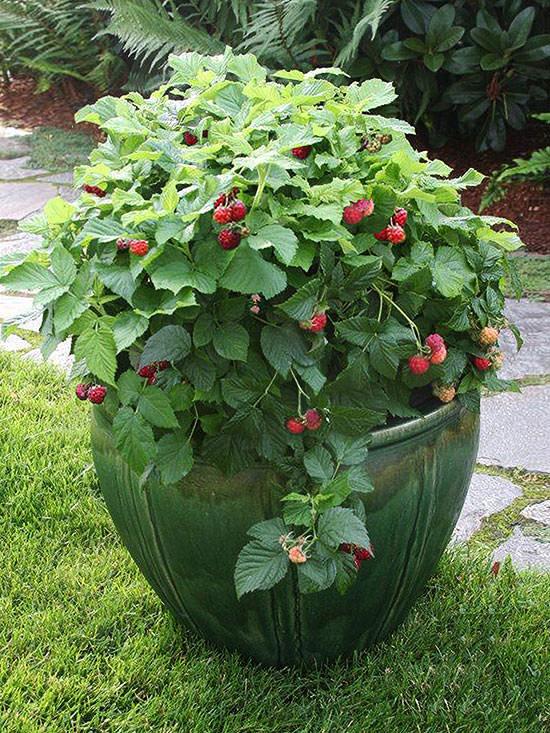
So don’t let the idea of using pots and containers limit you to marigolds and petunias! Use them to your full advantage and try these unexpected plants in containers!
2
0
文章
Gina
2017年05月22日

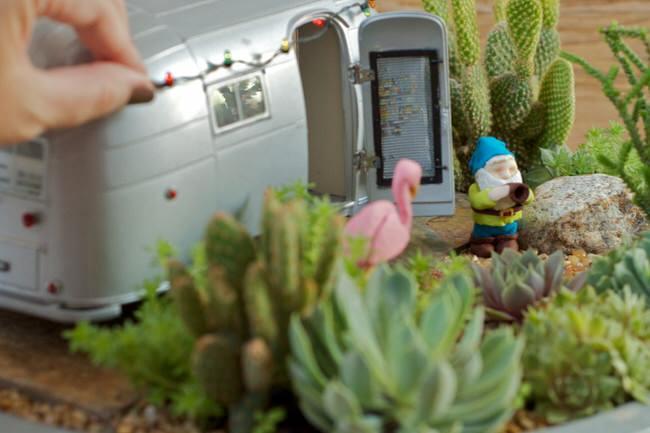
I have to admit, I’ve become a sucker for those miniature garden worlds called fairy gardens. The ability to create a scene or a memory in a garden that can be viewed close up, in detail… it’s a little bit fantasy, and part of the world of art. Both of which belong in a garden! They make it easy to be creative, even if your space is limited. (Or too large, for that matter). They make great gifts when done in containers and can be brought indoors at least part of the year. And here’s the thing… fairy gardens don’t always necessarily have fairies in them… Sometimes called mini gardens, they are “fairy sized”… Populating them with actual fairies is entirely a matter of taste! If you think you’ve seen it all at your local nursery though, we bet we can surprise you with at least one of these unique and creative fairy gardens. These are sure to inspire you, and some DIY tutorials are here to boot. Our feature photos above and below, are from ‘Lush Little Landscapes‘. This should be your first stop if you want to learn about making really unique fairy, or miniature gardens. They have some how-to information, some project guides and lots of info on where to find supplies. Most important, as these photos attest… they are inspiring!

Make a hobbit house with bonsai! ‘Bonsai Empire’ takes you through this project step by step… If you are a “Lord of the Rings’ fan, what a story to tell in your garden.

I’d like to introduce you to Janet Calvo… She is the author of “Gardening In Miniature“, a book which I own and highly recommend if you are interested in getting into this craft. She also has a great blog, at her website ‘Two Green Thumbs‘. AND a mini gardening shop online with all kinds of unique pieces you won’t find other places. Oh, and I love that she is based in Seattle, my favorite place on earth… Wonder if she would fancy a visit? Janet? :) The next two photos are from her, and they are truly inspiring! Really, get her book! I got it in Kindle, and it’s just amazing.
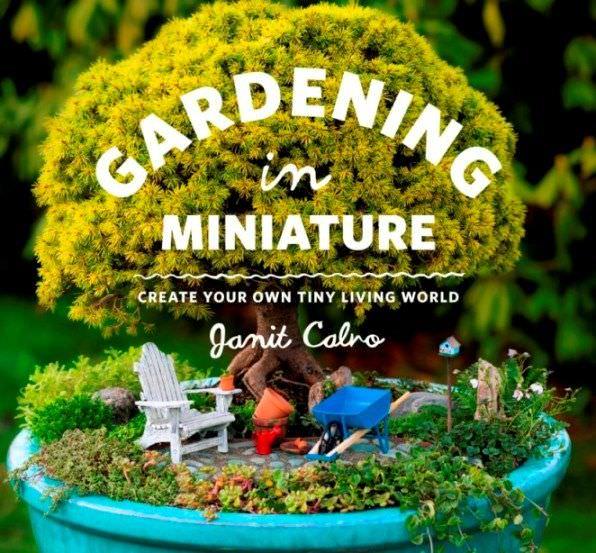
Janet teaches you how to use snow in your fairy garden!
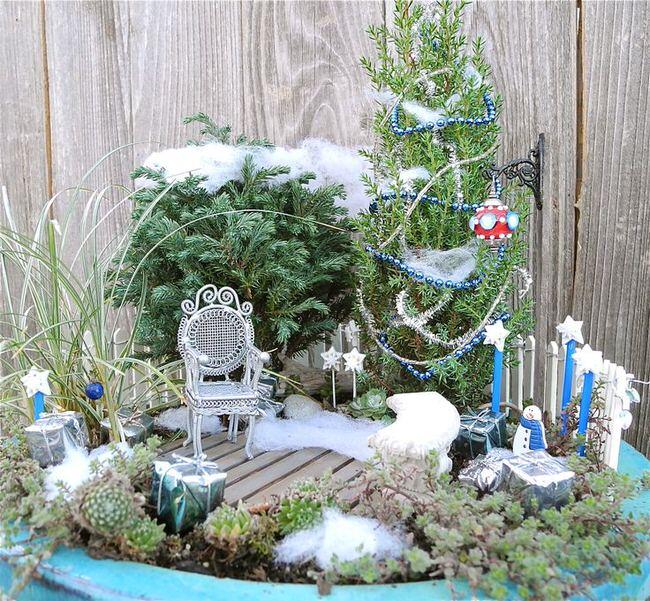
Also from Janet… Love the balloons!
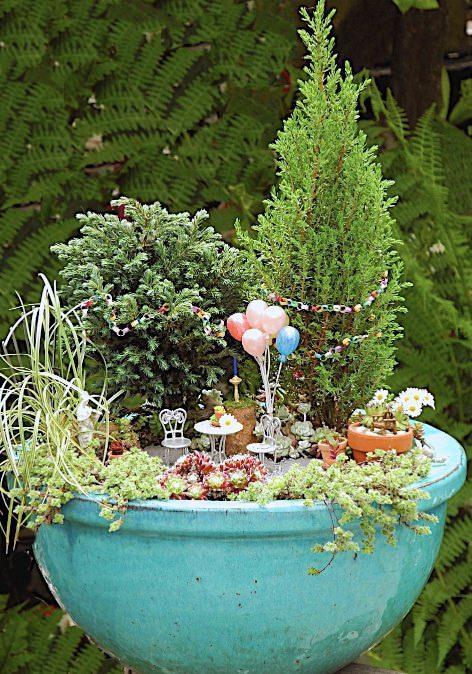
Inspirational miniature garden ideas by ‘Melissa Mercier‘…

Another inspirational photo, from ‘Florence Griswold Museum‘, this Emerald City fairy house is truly unique!

Last, we have a couple of fairy gardens made from those old tree stumps you don’t know what to do with! This first one from an artist at the ‘Sequin Market‘.

This next one is very cute! From ‘The Owner Builder Network‘.

Finally, from Wendy on ‘Hometalk‘… This stump fairy garden is perfect, and can weather and age with time!

2
1
文章
Joss
2017年05月22日

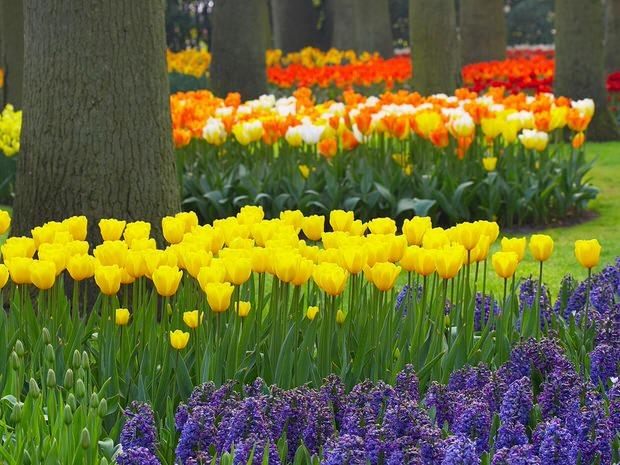
We all do it every spring…we lust after those gorgeous bulb gardens, full of bright colors after a long gray winter… And every year we say, “Next spring I’m going to have a garden like that!” Well this is your year, because not only is TGG going to give you an easy to understand primer on which bulbs to choose, we are going to show you exactly how to choose, buy and design with them this fall so that next spring your yard will be the envy of the block!
Planning the Bulb Garden
Unless you are planning to plant hundreds of bulbs in full public garden style (not recommended for the average gardener!) planning a bulb garden isn’t complicated. Here are a couple of guidelines to keep in mind.
Choose just two or three types of bulbs to use in your yard. Using just a few of every pretty bulb out there will just leave your garden looking cluttered and lost, without the impact you are looking for. Use the same bulb in groups and drifts for the best design strategy.
Choose bulbs that bloom at the same time. Most bulbs bloom for just a few short weeks every spring, and to get the best effect, choose ones that bloom together. Bulbs are classified into early season, mid season and late season bloomers. If you want the most impressive show, plan your bulb garden to either all bloom at once, or to have several different shows in each classification.

For instance, you could choose a mid season tulip, daffodil and grape hyacinth (my fav combo, btw) and create a one time show with larger groups of those three bulbs. Or, you could create smaller shows of each an early season group, mid season group, and late season group so that something is always in bloom. There is no right answer, just depends on how much time and planning you wish to put into you bulb garden.
Choose a color scheme for you bulb garden. Want gentle, sweet pastels, or bright and vibrant colors? Complementary colors grown together, such as red and blue, or yellow and blue are always show stoppers. A bulb garden looks best though when the color scheme is consistent.
Plan cover ups. After bulbs finish blooming, their greenery withers, but you can’t cut them back yet if you plan on them returning the following year. Plant a ground cover or sprawling perennials around and through your bulb garden so that as the bulbs finish, they and other plants will be naturally growing over the stalks to cover and hide them.
How to Choose Bulbs
Don’t buy discount bulbs at the local stop and shop. Quality and health of your bulbs will make all the difference in both display, and their ability to return, and multiply year after year. Here’s how to choose healthy bulbs.
Buy from a trusted online source. Two that we use and depend on are DutchBulbs.com and WhiteFlowerFarm.com.
Another reliable choice is your local plant nursery – not your local home improvement store. If you want small flowers and a wimpy display, then you go ahead and buy those bulk bags at Walmart.
Choose bulbs that are smooth and free of defects.
Buy “top grade” bulbs. This refers to their size, and yes, size matters. If they aren’t marked top grade, they aren’t top grade!

Finally, wait until late fall to plant your bulbs, but before the ground freezes. Find out from your nursery their recommendation for planting depth for your particular bulbs for your area – it can vary due to winter cold.
You can have that gorgeous spring bulb garden if you plan now, so take our advice, and start shopping now before the best bulbs are sold out!
2
2



